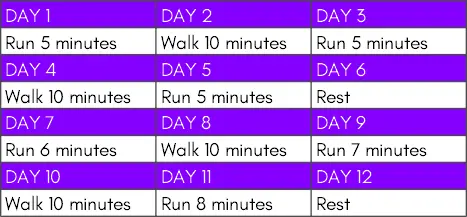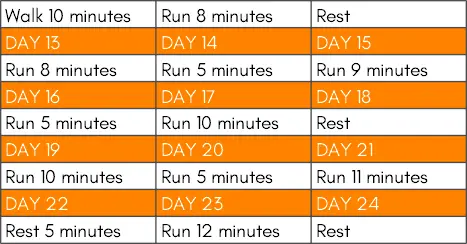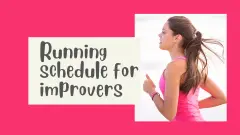Starting to run isn’t easy. Although it’s a natural activity, once we become adults we rarely do it unless we engage in sport or fitness. Running is hard work for our hearts and legs and if you’re out of practice it can seem almost impossibly hard. It’s also a high impact activity which may feel uncomfortable if you’re not used to it. This running challenge for beginners eases you in, starting with just 5 minutes of running. It also has rest days and “active rest” days where you walk or do a short run.
Running challenge for beginners schedule
Days 1-12
For the first 12 days, running alternates with walking.

Days 13-24
After day 12, it’s running every day, with a short 5 minute recovery run every other day.

Days 25-30
In the last 6 days, the longer run gets up to 15 minutes, while the recovery run is 8 minutes.

Planning a route
Each day you’ll cover a different distance, so to keep route planning simple:
- Plan a route that is at least 1.5km/1mile in length. This should be long enough for all the runs, including warm ups and cool downs (see below).
- Each day, run (or walk) along your route for half that day’s time and then turn around and come back. So, for example on day 1 you would follow your route for the warm up plus 2.5 minutes running before turning around. As you progress through the challenge, you will be travelling further along your route each day.
Starting to run – what you need
You need comfortable clothes, preferably with layers that you can remove. Although it’s not necessary to buy expensive running shoes, you should wear training shoes that will cushion some of the impact of running. You should also take a bottle of water with you.
Buying a treadmill for home use
Now that folding treadmills are widely available, having a home treadmill doesn’t mean you need a dedicated workout space. You can fold your treadmill up and store it out of the way between workouts. If you’re thinking of buying a home treadmill, here are some points you should consider:
- If you’re going to be using the treadmill for running, avoid very lightweight models that are only suitable for walking speeds. Also, a cushioned running/walking deck will help to absorb impact.
- Dimensions: there’s a slight variation in dimensions between models. If you’re tall, you might prefer a longer walking/running deck to allow for a longer stride. Obviously, the treadmill needs to fit in your chosen storage place when it is folded away.
- What sort of a console do you want? Is it important to you to have a multi-feature console with a choice of preset programs, or will you be happy with something simple that just lets you set speed and incline? Extra functions add to the cost of the treadmill, so think about whether you really need them.
- What is the incline range? Some treadmills only have a limited incline range. Models that offer up to 12% give you more options to vary your workouts and to challenge yourself more as your fitness improves.
- Maximum speed – if you run fast, or plan to do sprint intervals, you should bear the maximum speed in mind. For walking, or average speed running, any treadmill will be fine.
See a treadmill buying guide here
General exercise safety
Warming up and cooling down: Before starting to run, you should walk for 2-3 minutes to give your muscles and joints time to warm up. At the end of your run you should walk again until your heart rate and breathing return to normal.
General exercise guidelines: please read this exercise safety information before you start.
Related to starting to run
Challenge FAQs
The first day of the challenge should feel like it needs a bit of effort, but not too much. If you really struggle with day 1, then you probably won’t get through the challenge. The idea with the challenges on this site is that the first few days get you used to the exercises and the daily habit. Usually about halfway through the challenge the effort levels start to increase more quickly.
Avoid challenges that increase effort levels very quickly – they’re simply not realistic. It’s unlikely that, for example, you would be able to increase how many squats you are able to do by 10 a day for 30 days, or increase your plank hold time by 10 seconds a day for 30 days.
In general, allowing muscles 48 hours between workouts is good because it gives our bodies time to recover and adapt. Challenges are generally short workouts and for a limited period of time (usually 30 days), so not having many rest days won’t be a problem. With challenges that alternate exercises each day, it’s not an issue, because you’re using different muscles.
Fitness improvements don’t always happen in a predictable way. Sometimes we’re just not as strong or energetic for no apparent reason, or we hit a plateau. If you get to a point where you’re struggling to complete the day’s challenge, you can try one of the following:
- Take a couple of days off and start again where you left off
- Do the challenge on alternate days rather than every day
- Instead of increasing the effort every day, stay at the same level for 2 or 3 days and then go onto the next day of the challenge
Obviously these solutions mean the challenge will last longer, but you’ll still benefit from doing it.

